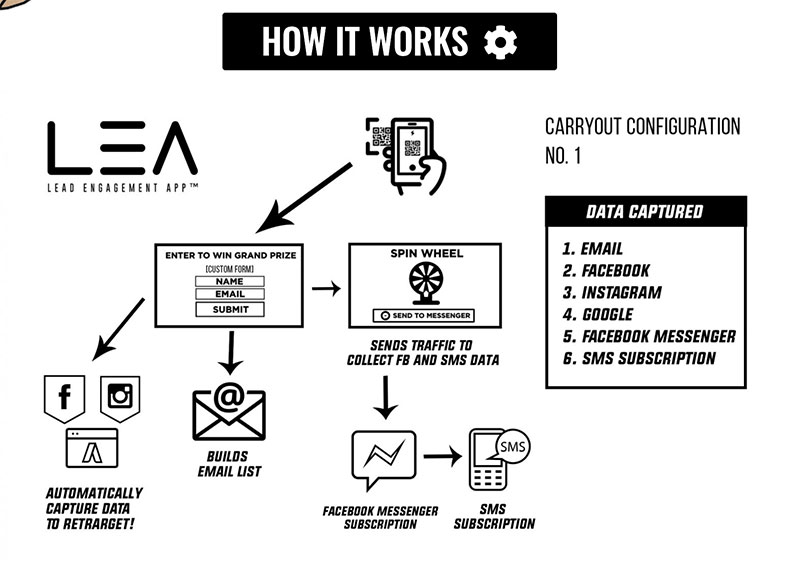The humble QR code is getting a second act in this newly touchless world, as many tech providers and restaurant brands are using the blocky square codes to send menus or discount codes right to customers’ phones without any employee contact required. One such brand is Carryout Rewards, which is a startup using flyers with QR codes to give restaurants the ability to market directly to third-party delivery customers, with the goal of converting them to in-house, native ordering channels.
Dreamed up by off-road racer and social media expert Jeff Vanasdal, the idea for Carryout Rewards was the result of a conversation with his girlfriend who was frustrated that she wasn’t able to get Starbucks loyalty points when ordering through third-party delivery apps. That simple challenge, which has morphed into a major priority for restaurant brands looking to capture customer data and lower fees paid to delivery brands.
Already experienced at using QR codes to replace iPads at trade shows, the restaurant application of the Carryout Rewards technology has new urgency now that the pandemic is forcing the foodservice industry to make drastic changes to its delivery and curbside economics to survive whatever comes next with the COVID-19 pandemic.
Even though QR codes may sound like a throwback to 2007, the ability to bring consumers to a live menu, ordering portal or even just a digital restaurant menu is seeing new life a decade-plus later. One thing that’s supporting a revival of QR-based technology is that users are no longer required to download a separate application to use the codes. Now, basic phone cameras on iPhone and Android phones include that technology from the factory, and a handful of brands are finding the throwback tech a perfect fit for this new, hands-off era.
Under the umbrella brand of LEA, which stands for Lead Engagement App, Vanasdal’s Carryout Rewards is a new application of an earlier idea that never took off in the restaurant space. Using the foundational idea that people can be influenced through drawings for discounts or free stuff, the brand gives restaurants an easy way to incentivize delivery and carryout users to go through more profitable channels that give the restaurant a way to capture customer information and market directly to them using social media accounts.
“You scan the QR code, it lands on a page that asks for your email address, and once you land on that page, we already have your information, can tell what device you scanned it on, where you’re at and what social media accounts you’re on, so we can then retarget you on Facebook, Instagram and Google,” Vanasdal said, adding that users can spin a virtual wheel to win free products or discounts, like 25 percent off your next order through native channels. “Even though they order the first time through DoorDash, if they scan that QR code, they can claim that [coupon], but they have to order directly through the restaurant, which incentivizes them to do that instead of DoorDash.”
With the customer data and social accounts in hand, Carryout Rewards exports the data, which can be plugged into a restaurant’s own CRM or marketing campaigns.
The company is also able to add click-to-order functionality, to further capitalize on customers looking for a better deal or motivated to support their restaurants in a time when so many are closing, temporarily or permanently.
Because Carryout Rewards is still an early-stage company, Vanasdal said pricing varies, but he’s currently targeting $97/month, as a flat fee, rather than pricing that increases with volume. Based in Indianapolis, Carryout Rewards is currently working with a local seafood restaurant on a pilot basis, but is looking to expand beyond its home metro area in the coming months.
As everything from employee training to customer loyalty apps are “gamified,” it’s not unreasonable to expect that providing a clear incentive to changing ordering behavior could be boosted by turning the process into a handheld version of Wheel of Fortune.


